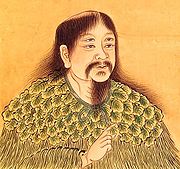- Cangjie
-
This article is about the legendary figure. For the typing method, see Cangjie input method.
Cangjie 
Portrait of Cangjie showing his four eyes and four pupils Traditional Chinese 倉頡 Simplified Chinese 仓颉 Transcriptions Mandarin - Hanyu Pinyin Cāngjié - Wade–Giles Ts'ang Chieh Cantonese (Yue) - Jyutping Cong1 Kit3 - Yale Romanization Chōng Kit Cangjie (simplified Chinese: 仓颉; traditional Chinese: 倉頡; pinyin: cāngjié; Wade–Giles: Ts'ang-chieh) is a very important figure in ancient China (c. 2650 BC), claimed to be an official historian of the Yellow Emperor and the inventor of Chinese characters.[1] Legend has it that he had four eyes and four pupils, and that when he invented the characters, the deities and ghosts cried and the sky rained millet. He is considered a legendary figure rather than a historical figure, or at least, not considered to be sole inventor of Chinese characters. The Cangjie method, a Chinese character input method, is named after him. A rock on Mars, visited by the Mars rover Spirit, was named after him by the rover team.[2]
Contents
Legend of character creation
 Lee Lawrie, sculpted bronze figure of Cangjie (1939). Library of Congress John Adams Building, Washington, D.C.
Lee Lawrie, sculpted bronze figure of Cangjie (1939). Library of Congress John Adams Building, Washington, D.C.
Shortly after unifying China, the Yellow Emperor, being terribly dissatisfied with his "rope knot tying" method (e.g., Quipu) of recording information, charged Cangjie with the task of creating characters for writing. Cangjie then settled down on the bank of a river, and devoted himself to the completion of the task at hand. Even after devoting much time and effort, however, he was unable to create even one character. One day, Cangjie suddenly saw a phoenix flying in the sky above, carrying an object in its beak. The object fell to the ground directly in front of Cangjie, and he saw it to be an impression of a hoof-print. Not being able to recognize which animal the print belonged to, he asked for the help of a local hunter passing by on the road. The hunter told him that this was, without a doubt, the hoof-print of a Pixiu, being different from the hoof-print of any other beast alive. His conversation with the hunter greatly inspired Cangjie, leading him to believe that if he could capture in a drawing the special characteristics that set apart each and every thing on the earth, this would truly be the perfect kind of character for writing. From that day forward, Cangjie paid close attention to the characteristics of all things, including the sun, moon, stars, clouds, lakes, oceans, as well as all manner of bird and beast. He began to create characters according to the special characteristics he found, and before long, had compiled a long list of characters for writing. To the delight of the Yellow Emperor, Cangjie presented him with the complete set of characters. The emperor then called the premiers of each of the nine provinces together in order for Cangjie to teach them this new writing system. Monuments and temples were erected in Cangjie's honor on the bank of the river where he created these characters.[1]
Cang Jie text
The book Cang Jie, consisting of only 28 characters, was ascribed to Cang Jie and honored as the earliest Chinese text known to the ancients. However, it is suspected to be authored by Liu Xin. Alternately, it is associated with the Yi people.
See also
References
 Media related to Cangjie at Wikimedia Commons
Media related to Cangjie at Wikimedia Commons- ^ a b Zhang, Shudong (2005) (in Chinese). 《中华印刷通史》 (A General History of Chinese Printing). Taipei: XingCai Literary Foundation. pp. ch.3, sec.1. ISBN 957-99638-3-5. http://www.cgan.net/book/books/print/g-history/big5_12/03_1.htm#031.
- ^ "為火星目標地中文命名 王阿蓮博士為世界華人爭得殊榮 (Mars destinations given Chinese names, Dr. Wang gets honor for all Chinese people)" (in Chinese). 聖路易時報 (St. Louis Chinese American News). 2006-02-23. http://www.scanews.com/2006/02/s809/80902/. Retrieved 2008-03-07.
Categories:- 27th-century BC people
- Inventors of writing systems
- Chinese characters
Wikimedia Foundation. 2010.
